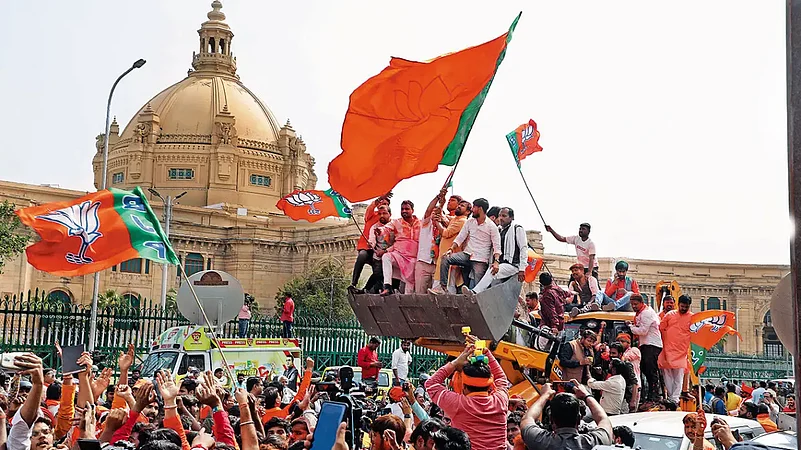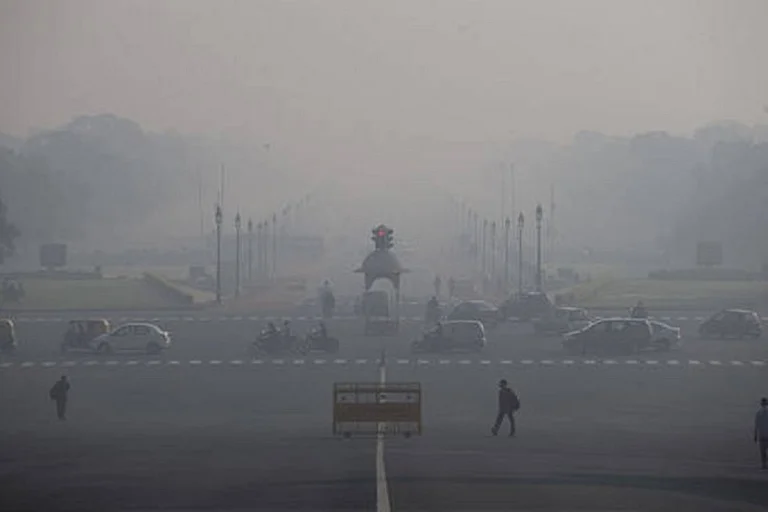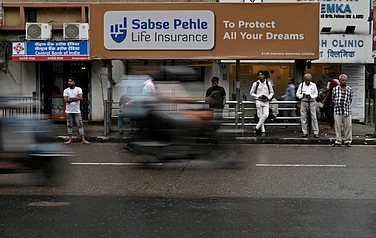This is the cover story for Outlook's 16 May, 2022 magazine issue 'Demolition Row'. To read more stories from the issue, click here
In his short story, In the Penal Colony (1919), Franz Kafka writes about a special machine for enforcing capital punishment. As part of the punishment, the machine also inscribes on a person’s body the commandment they have disobeyed. The condemned person in the story is required to get these words etched on his skin: “Honour Thy Superiors”. If the failure to obey the superiors was sufficient to invite public execution in a fictional tale a century ago, one’s alleged criminal record is now enough to attract public punishment and a voyeuristic celebration. Last month, Ramesh Sachan, a government officer in Hamirpur district of UP, posted a photograph of a bulldozer on social media and wrote: “Yah hum hain, aur yah hamari car hai, yah hamari party ho rahi hai. (Here we are, this is our car and here we are holding our party).” A day before, the administration had bulldozed the property of a suspected criminal in the district. Coming from an officer, the telling words epitomised the space the monstrous machine has recently occupied in Indian administration.
ALSO READ: Tentacles Of Power
The bulldozer is not executed in stealth or silence. It’s a performance in public. Its allure as well as its terror lay in its brazen visuals. It turns hapless cries into a spectacle and invites cheerleaders to derive a joy out of the victim’s sorrows. The bulldozer is a kangaroo court, a modern version of the guillotine. It subverts principles of justice and philosophy of jurisprudence. It holds no negotiation or conversation with those it believes are its adversaries; it razes them to the dust. Its force lies in not merely what it does, but what it is. Long before the giant blade descends upon its adversary, the word bulldozer itself evokes multiple emotions of seduction, hypnotism and terror. The shape, size and appearance of this aesthetically unpleasant but seemingly invincible machine can be simultaneously fascinating and intimidating, depending on the side of the fence you are on. It’s a tank deployed for civil destruction. With its ability to flatten structures and clear debris, it was a prime asset of the allied powers in WWII, beginning with the assault on the Normandy coast. In 1944, when the war was still raging on, a US Army officer Colonel K. S. Andersson wrote an essay, The Bulldozer—An Appreciation. “Of all the weapons of war,” he wrote, “the bulldozer stands first. Airplanes and tanks may be more romantic, appeal more to the public imagination, but the Army’s advance depends on the unromantic, unsung hero who drives the ‘cat’.” The officer had predicted the future of the machine in precise and penetrating words.
***
Of the various forms of punishment, retributive or an eye for an eye is the most primal one. The bulldozer is several notches ahead. Its retribution is grossly disproportionate because when the home of an accused is demolished, their innocent family becomes the inevitable targets. Since even a convict deserves only the punishment prescribed under the law and certainly not the demolition of one’s home, the machine essentially violates the Right to Equality under Article 14. Its blade strikes at the core of constitutionalism.

The SC had held in the Olga Tellis vs Bombay Municipal Corporation (1985) case that the right to housing comes under Article 21, which also mandates a right to be given a notice and heard before the eviction, as well as rehabilitation under the government schemes. Over two decades later, the Delhi High Court in the Sudama Singh & Others vs Government of Delhi (2010) case elaborated on the guidelines and made it “the State’s constitutional and statutory obligation to ensure” that the rehabilitation “has to be a meaningful exercise consistent with the rights to life, livelihood and dignity” of the affected people.
But the monster machine is now being deployed to construct the perception of a tough leader, an urban legend, which gets intensified with monikers like Bulldozer Baba and Bulldozer Mama. In March, BJP MLA Rameshwar Sharma in Madhya Pradesh parked several bulldozers outside his government residence in Bhopal with a billboard that said: “Beti ki suraksha mein jo banega rora, mama ka bulldozer banega hathoda (Uncle CM’s bulldozer will demolish those who impede the safety of daughters).” A few days later, Sharma welcomed CM Shivraj Singh Chouhan with slogans of “Bulldozer Mama Zindabad”. A blatantly illegal act now brings political dividends. It was reported after the BJP’s victory in the recent Uttar Pradesh elections that CM Yogi Adityanath mentioned the word bulldozer during rallies at 58 places—the party won all those seats. Such are the cheerleaders that several young men in Agra tattooed the images of the bulldozer and Bulldozer Baba on their bodies after Yogi’s victory.

The building of a political image around the bulldozer is not unique to India. When Richard C. Lee, the former mayor of New Haven, died at 86 in 2003, an obituary in the New York Times noted that his “urban renewal programmes in the 1950’s and 1960’s earned national recognition and created a template for decades of future city revitalisation projects”. He “leveraged hundreds of millions of dollars from the state and federal governments to raze blighted city neighbourhoods, feats documented in national magazines and newspapers”. The obit didn’t note the methods he had deployed. In her remarkable book, Bulldozer: Demolition and Clearance of the Postwar Landscape, Francesca Russello Ammon detailed how Lee’s operations with the bulldozer made him a national celebrity. During a demolition drive in 1958, he even occupied the driver’s seat and, with “a supportive crowd assembled around him, Lee swung the crane’s skull cracker against the brick walls of an ageing tenement building”.
As is now the case in India, journalists were present at the spot to cover the demolition in the US. The high-profile mayor often staged the destruction of buildings before journalists and visiting dignitaries. “Some mayors give out keys to the city. We knock down buildings for our guests,” Lee once said. By that count, Indian rulers were considerate enough to not have organised a live show for the visiting UK PM Boris Johnson, who had to contend with a pose atop a bulldozer.
***
The leader and the lever combine to form a modern mythology. A symbol of unrestrained masculinity, the shape and the operation of its blade insinuate a phallic victory. For a society obsessed with the image of a tough ruler, it’s a political weapon with unbridled power. Precisely, therefore, the bulldozer is incomplete without the hysteric cheerleaders. It’s not a secret torture chamber inside a dark prison. It invites people to participate in the spectacle. It allows a photographer to stomp on a dying man who was injured in police firing when he was protesting against a forcible eviction. It offers a TV anchor a ride to do a live show of the demolition, and the anchor, with the thrill and frenzied excitement, makes it look like war reporting. From its windshield the scene outside perhaps looks like a video game on a giant screen, with its lever being the joy stick and hapless people the enemies to be crushed. The bulldozer will lose much of its glamour and force in the absence of a hysteric audience, who also try to construct a moral and legal foundation of the act.
Mob justice serves various purposes for a society that is in the grip of multiple internal and external crises. It offers a nationalistic jab to the people, lends them a semblance of strength and authority, helps restore their trust in both the rulers as well in themselves. More importantly, the display of might also assuages anxieties about China. The bulldozer becomes a modern chariot, the driver evokes the aura of the mythical charioteer who can ram the vehicle into unimagined places and conquer the diffident territories.
***
A demolition essentially erases a part of life that you cannot face or accommodate. When foreign invaders destroy religious shrines, when the Taliban bombs the Buddhas of Bamiyan or when a mob brings a mosque down, or when hutments along the Yamuna are removed to facilitate the Commonwealth Games in Delhi, the inherent purpose is to refute an aspect of life you find uncomfortable. In Thus Spoke Zarathustra, Nietzsche wrote about the psychology behind inflicting violence on stones. Because there are stones that “he cannot move”, “so he moves stones out of wrath and displeasure, and he wreaks revenge”. But since he can’t publicly call it revenge, he names it a form of “punishment” and “feigns a good conscience for itself with a lie”. When the bulldozer identifies its targets on the basis of religion in order to instil fear among its intended targets, it becomes an act of revenge in the garb of punishment.
***
Not all demolitions carry a religious colour. Some bulldozers arrive with the grand ambition of redesigning a landscape. The treachery of this secular project is not easy to detect. But unravel the redesigned area and one finds new and rich settlers, with the original and evicted inhabitants often remaining homeless and waging long battles in courts. Hundreds of villagers were evicted to construct Naya Raipur, the new capital of Chhattisgarh, over a decade ago. The new landscape is now a fascinating zone with stunning roads and buildings, but several villagers continue to hold protests against the land acquisition.

Like the victims of religion-based demolitions, those of the secular bulldozer also mostly come from the disadvantaged sections. In both the cases, they are assigned a new identity, a derogatory category of citizenship: dispossessed, homeless. The Delhi HC in the Sudama Singh case used scathing words to describe the State’s apathy towards such people. “It is not uncommon that in the garb of evicting slums and beautifying the city, the State agencies in fact end up creating more slums, the only difference is that this time it is away from the gaze of the city dwellers.”
ALSO READ: Crushing Dreams And Livelihoods
The situation has not been dissimilar in the oldest democracy. James Baldwin famously termed the urban renewal programme “Negro removal”. Brent Cebul, an assistant professor of history at the University of Pennsylvania School of Arts & Sciences, noted in an article that “while Black Americans were just 13 per cent of the total population in 1960, they comprised at least 55 per cent of those displaced” due to the demolitions.

But where do the displaced and dispossessed people go? In February 2014, I met a Maoist commander Jaylal in Bastar. He was a short man of 22 years, carrying an INSAS rifle and a pen-gun. He was studying in Class V in a government school when the Chhattisgarh government signed an MoU with the Tatas for a steel plant in Bastar in 2005. Adivasis erupted in protest against the land acquisition and some of them, like the young boy, joined the Naxal ranks. The Tatas, facing continuous protests, had to shelve the project a decade later, but by then Jaylal had become an accomplished guerrilla.
***
This is the story of the punishment machine as told through the lens of victims. But how does it look from the other side? Psychological research says that an unjust machine gradually nibbles at its handlers, leaving them spiritually dry and wasted. The officer in Kafka’s short story eventually places himself on the machine with the words “Be Just” to be inscribed on his body by its blade. He chooses the precise punishment for himself that he had been handing out to others: his only wish was to be just, which he could perhaps never be in his life.
The psychology of an unjust public spectacle has perhaps been best captured by George Orwell in an extraordinary essay, Shooting An Elephant. He describes an incident when he, as an imperial police officer posted in Myanmar, was forced to fire bullets at the harmless animal because people wanted him to. “They did not like me, but with the magical rifle in my hands I was momentarily worth watching.” He found that he was an “absurd puppet pushed to and fro” by the people around him, “a hollow, posing dummy”, a “tyrant” who was destroying his “own freedom”. Orwell knew he was wrong, but faced with the frenzied crowd, he couldn’t stop himself.
The people who are now driving the bulldozer may not have such introspective consciousness, and hence may not have any means to confess their dark truths and redeem themselves. The repressed anxieties of such people for whom the bulldozer is a live game show can’t be easily anticipated. But we know that the mob that brought down a mosque three decades ago has now assumed dangerous forms. Unable to confront its carefully concealed fears, it now stands unleashed both online as well as on roads. One can lament the death of their spirituality, and one can also fearfully await the offspring of the bulldozer punishment.
(This appeared in the print edition as "Crushing Claws")
For a deeper understanding of the legal and social issues around bulldozer justice, read Outlook's reportage and commentary on the issue: Click Here.


























